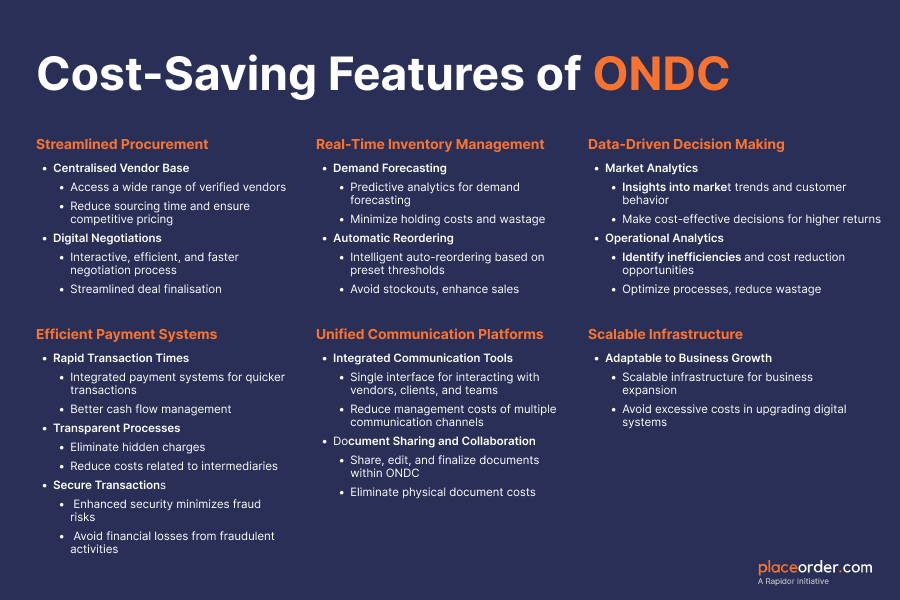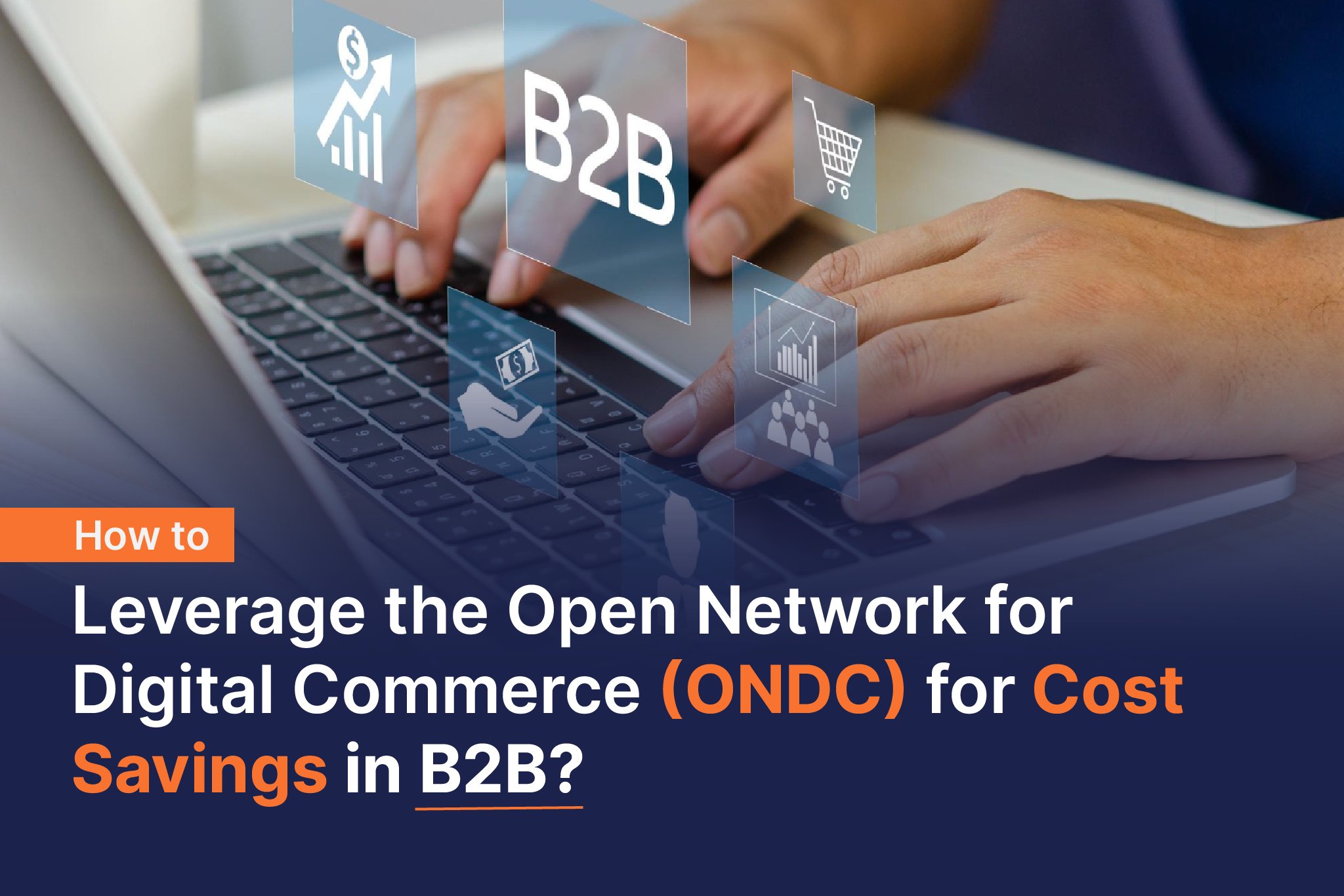In today’s competitive B2B marketplace, CEOs, CFOs, and operational managers constantly grapple with the challenge of streamlining expenses. Operational costs, which span from procurement to payment processing, represent a significant portion of an organisation’s outlay.
Balancing the reduction of these costs without sacrificing quality and efficiency is a persistent concern. But what if there was a digital solution that promised to address these challenges head-on?
Enter the Open Network for Digital Commerce (ONDC) – a revolutionary platform that holds the potential to transform the B2B commerce landscape in India and beyond. This guide discusses how to leverage ONDC for saving costs in the B2B market.
How Did Operational Costs Rise in B2B Commerce?
For many B2B organisations, the rise in operational costs isn’t just a fleeting concern – it’s an existential threat. The intricate processes involved in procurement, supply chain management, and payment systems often contribute to increasing overheads.
Traditional methods, fraught with manual interventions and legacy systems, can lead to inefficiencies, errors, and delays. Such challenges don’t just dent the bottom line but can also strain business relationships and impede growth.
Why is ONDC the Game-Changer for B2B Organisations?
The ONDC isn’t just another digital platform; it’s a transformative initiative designed with the specific challenges of B2B commerce in mind. By offering a unified, digital ecosystem, ONDC promises to streamline procurement processes, offer efficient payment systems, and reduce redundancies.
Let’s delve deeper into how ONDC can pave the way for substantial cost savings:
Streamlined Procurement
Gone are the days when procurement meant navigating through a maze of vendors, manual order placements, and cumbersome negotiations. ONDC provides a consolidated platform where businesses can connect with verified vendors, compare offerings, and make informed decisions.
This not only reduces the time and effort spent on procurement but also ensures that businesses get the best value for their investment.
Efficient Payment Systems
Payment delays and inefficiencies can cost B2B organisations both time and money. ONDC’s integrated payment systems promise quicker transaction times, transparent processes, and reduced risks of errors or fraud.
Such features can lead to better cash flow management and reduced operational costs.
Data-Driven Insights
In the age of information, data is the new gold. ONDC provides businesses with actionable insights derived from real-time data. These insights can guide organisations in optimising their operations, making cost-effective decisions, and staying ahead of market trends.
Enhanced Security and Compliance
Compliance and security breaches can result in hefty fines and a tarnished reputation. ONDC’s robust security features ensure that businesses operate within the regulatory framework and are protected against potential threats.
What are the Operational Costs in Traditional B2B Commerce?
B2B commerce has long been an arena dominated by traditional methods and systems. These methods, although tried and tested, come with a hefty price tag in the form of operational costs.
As the digital age dawns, it’s worth examining these costs to understand the imperative for B2B organisations to transition towards more efficient systems, like the ONDC. Here, we dissect the common operational costs that have been a thorn in the side of many B2B enterprises.
Manual Procurement Processes
Traditional B2B commerce relies heavily on manual procurement systems. These entail physical paperwork, human intervention at multiple levels, and often long lead times.
From seeking quotations to placing orders and managing receipts, the inefficiencies in manual processes add significant operational costs.
Inventory Management
In a traditional setup, inventory management can be cumbersome and error-prone. Lack of real-time data means businesses either stock up excessively, leading to higher holding costs, or under-stock, resulting in lost sales opportunities and unsatisfied customers.
Payment Inefficiencies
Traditional B2B payment methods, be it cheques or bank transfers, can be slow and lack transparency. Such systems often lead to delayed payments, reconciliation issues, and potential cash flow bottlenecks, further inflating operational costs.
Lack of Unified Communication Platforms
The absence of a unified digital communication platform in traditional B2B commerce results in fragmented interactions across emails, phone calls, and face-to-face meetings. This fragmented approach can lead to miscommunication, delays, and, inevitably, higher costs.
Compliance and Regulatory Overheads
Managing compliance in the traditional B2B realm, without the aid of digital tools, can be labour-intensive. Regular updates to regulations, coupled with the need for periodic audits and manual record-keeping, contribute substantially to operational costs.
Logistics and Supply Chain Inefficiencies
The traditional logistics and supply chain models, without the advantage of real-time tracking and optimization algorithms, often lead to higher transportation costs, warehousing expenses, and inefficiencies in the movement of goods.
Inability to Leverage Data
Traditional B2B commerce doesn’t easily allow for the capture and analysis of extensive data. This absence means businesses miss out on insights that can streamline operations, predict market trends, and optimise costs.
What is ONDC and How Does it Work?
The modern world of commerce is swiftly evolving, driven by rapid advancements in technology and the ever-growing demands of the global market. At the forefront of this evolution is the Open Network for Digital Commerce (ONDC).
As the name suggests, ONDC isn’t just a platform. It’s an initiative aiming to reshape and simplify the digital commerce landscape, especially in the realm of B2B trade.
ONDC: An Overview
ONDC is a unified digital platform that provides a holistic ecosystem for businesses to interact, transact, and grow. Beyond just a marketplace, it stands as a beacon for standardisation and efficiency in digital commerce, particularly catering to the unique challenges of the B2B sector.
What is the Mission of ONDC?
The core mission of ONDC is simple: to revolutionise digital commerce by making it more transparent, accessible, and efficient. By bridging gaps, eliminating redundancies, and providing a seamless interface for trade, ONDC aims to cater to both seasoned businesses and nascent startups.
This ensures that no entity is left behind in the digital transition.
How Does ONDC Work?
Unified Marketplace
ONDC offers a consolidated platform where businesses, be it manufacturers, dealers, distributors, or service providers, can list their products and services. This creates a vast pool of verified vendors and customers, ensuring a streamlined procurement process and competitive pricing.
Integrated Payment Systems
One of the standout features of ONDC is its robust and efficient payment infrastructure. By providing quicker transaction times and transparent processes, it ensures that payments are smooth, secure, and reconciled without hitches.
Data Analytics and Insights
ONDC harnesses the power of data, offering businesses real-time insights into market trends, customer preferences, and operational efficiencies. This data-driven approach allows businesses to make informed decisions, optimise operations, and stay ahead of the competition.
Enhanced Security and Compliance
ONDC’s infrastructure is built with a keen emphasis on security and regulatory compliance. By ensuring that transactions and data exchanges occur within a protected environment, it safeguards businesses against potential threats and compliance breaches.
Interoperability
Recognizing the diverse software and systems employed by different businesses, ONDC is designed to be interoperable. This means it can easily integrate with various business systems, ensuring a seamless transition and minimising disruption.

What are the Cost-Saving Features of ONDC?
In the B2B landscape, the race to reduce operational costs without compromising on efficiency or quality has always been a focal point. With the introduction of the Open Network for Digital Commerce (ONDC), a fresh wave of optimism has been infused into this sector.
ONDC, beyond being just a digital commerce platform, brings to the table a plethora of features tailored to cut costs and enhance operational efficiency. Let’s delve into the specific cost-saving features of ONDC and how they can usher in a new era of streamlined B2B commerce.
Streamlined Procurement
Centralised Vendor Base
ONDC boasts a vast, consolidated platform where businesses can access a wide range of verified vendors. This not only reduces the time spent in sourcing but also ensures competitive pricing through a transparent bidding system.
Digital Negotiations
Say goodbye to prolonged and cumbersome manual negotiations. IDC’s digital negotiation tools enable businesses to seamlessly interact, negotiate terms, and finalise deals in a fraction of the traditional time.
Efficient Payment Systems
Rapid Transaction Times
The ONDC platform is engineered for speed. Its integrated payment systems facilitate quicker transaction times, ensuring liquidity and better cash flow management for businesses.
Transparent Processes
ONDC’s transparent payment processes eliminate hidden charges, reducing the costs traditionally associated with banking and financial intermediaries.
Secure Transactions
Enhanced security protocols minimise the risks of fraud, thereby potentially saving businesses from financial losses associated with fraudulent activities.
Real-Time Inventory Management
Demand Forecasting
ONDC provides tools for predictive analytics, enabling businesses to forecast demand and adjust their inventory accordingly. This reduces holding costs and minimise wastage.
Automatic Reordering
Through its intelligent systems, ONDC can automatically reorder products or raw materials based on preset thresholds, ensuring businesses don’t miss out on sales due to stockouts.
Unified Communication Platforms
Integrated Communication Tools
With ONDC’s unified communication platform, businesses can interact with vendors, clients, and internal teams through a single interface, reducing the costs associated with managing multiple communication channels.
Document Sharing and Collaboration
Essential documents, contracts, and specifications can be shared, edited, and finalised within ONDC, eliminating the costs of physical document transportation and storage.
Data-Driven Decision Making
Market Analytics
ONDC’s data analytics tools offer insights into market trends and customer behaviour. By understanding the market better, businesses can make cost-effective decisions that yield higher returns.
Operational Analytics
Through analysis of internal operations, ONDC helps businesses identify inefficiencies and areas of cost reduction, enabling them to optimise their processes and reduce wastage.
Scalable Infrastructure
Adaptable to Business Growth
As businesses grow, so does their need for more robust systems. ONDC’s scalable infrastructure ensures that businesses can expand without incurring exponential costs in upgrading their digital systems.
How will ONDC Change B2B Commerce?
The realm of B2B commerce India stands at a pivotal juncture. As businesses grapple with the dual challenges of intensifying competition and rising operational costs, the need for innovative, cost-effective solutions has never been more pressing.
The Open Network for Digital Commerce (ONDC) emerges as a beacon of hope in this scenario, offering a transformative platform that goes beyond traditional commerce methods.
The potential of ONDC as a cost-saving tool is immense.
With features like streamlined procurement, efficient payment systems, real-time inventory management, and data-driven decision-making, it promises to overhaul the very fabric of B2B operations. No longer do businesses have to remain tethered to archaic systems that drain resources and hamper growth.
ONDC ushers in a new era where operational efficiency and cost savings coexist seamlessly.
Ready to Embrace the Change?
For CEOs, CFOs, operational managers, and every stakeholder in B2B organisations, the message is clear. The future of cost-effective B2B commerce is digital, and it’s embodied by platforms like ONDC.
By integrating ONDC into their operational framework, businesses position themselves at the forefront of digital innovation. And they also ensure sustainability through significant cost reductions.
In a world where every penny saved can be channelled into growth and innovation, can any business afford to ignore such a promising avenue? It’s high time for B2B professionals to explore, adopt, and leverage the myriad benefits of ONDC. Thus, steering their organisations towards a future marked by operational excellence and reduced costs.
The digital commerce revolution awaits, and ONDC is your ticket to join it.

